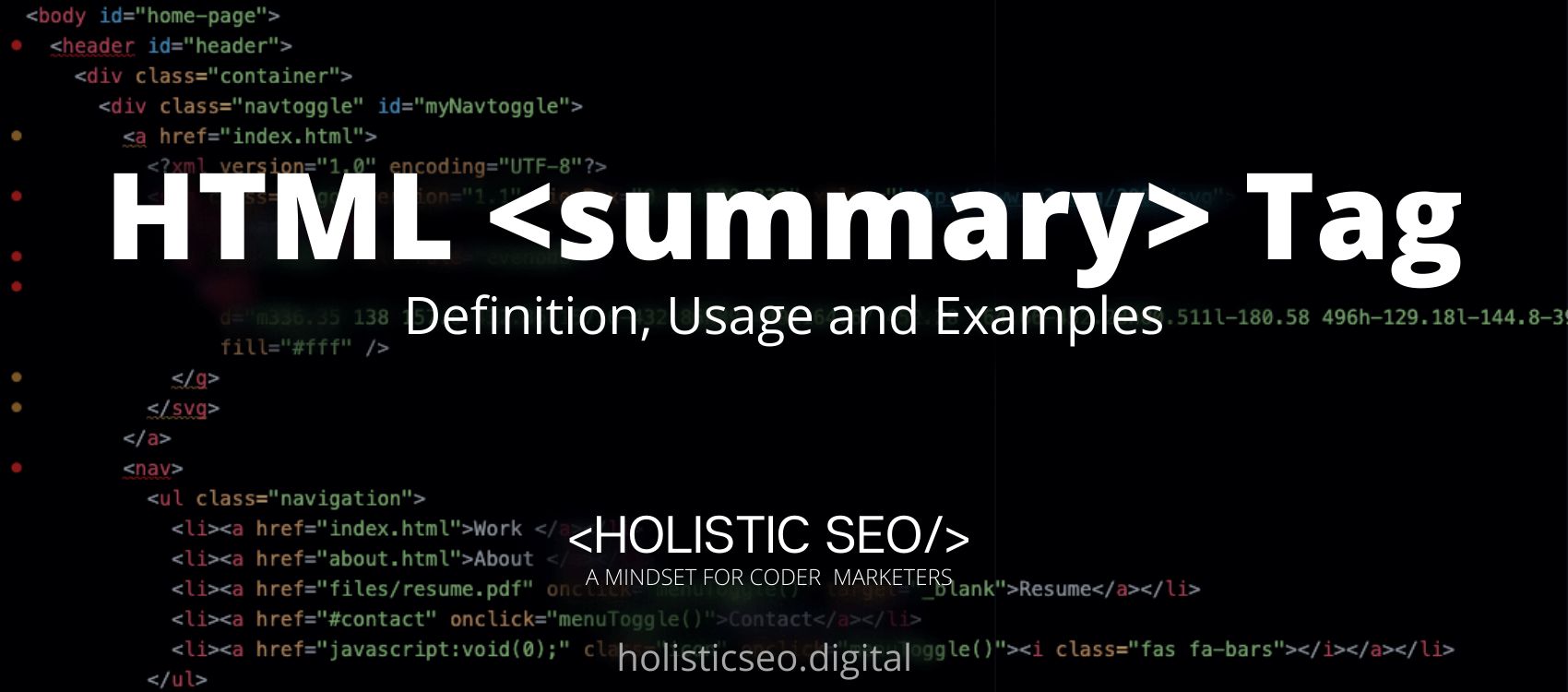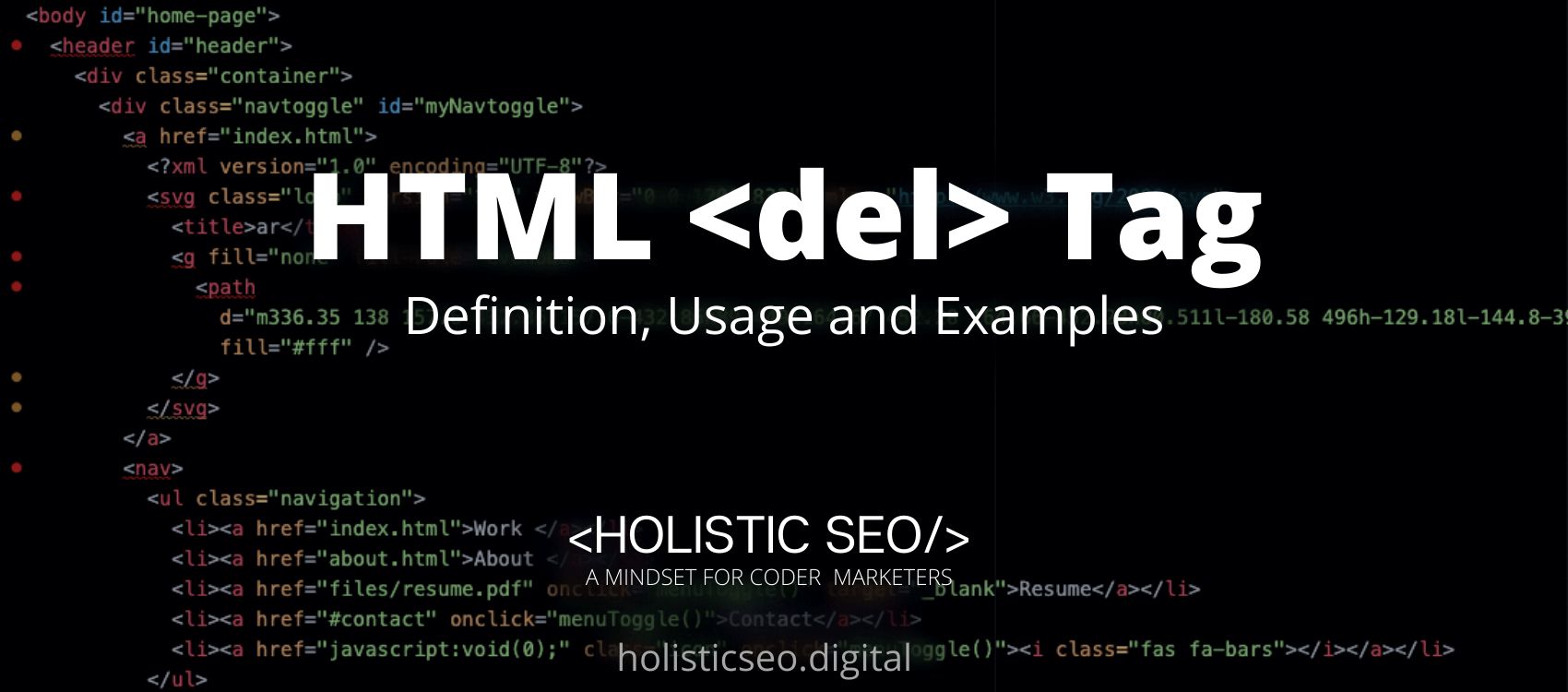The <summary> HTML Tag, defines a given visible header for <details> element. The details can be viewed or hidden by clicking the heading. To summarize the information in the <details> element, HTML uses the <summary> HTML Tag. There should be a <summary> HTML Tag below of the <details> element.The <summary> HTML Tag, although optional, is helpful when working with many <details> elements, as each <summary> HTML Tag can give an instructive legend that identifies each <details> element. The <summary> HTML Tag is part of the Styles and Semantics HTML category in HTML Element Reference.The attributes of the <summary> HTML Tag are global and event attributes.
<summary> code block example to learn how it works is given below.
<details>
<summary>Click to open</summary>
<p>Collapsible content...</p>
</details>The second example usage of the “<summary>” code block example is given below.
<details>
<summary>Holisticseo Summary</summary>
<p> Holisticseo is a well-known online resource.</p>
<p>On Holisticseo, you can find lessons on a wide range of topics, including HTTP, HTML, CSS, and more.</p>
</details> What is <summary> HTML Tag
The <details> element can be utilized in combination with the <summary> HTML Tag to specify a summary or legend. The details of this summary or legend can be expanded or collapsed by clicking on it. When a user clicks on the summary, previously hidden content in the <details> element becomes available.
How to Use <summary> HTML Tag?
To use the <summary> HTML Tag, the web developer should write the <summary></summary> with summary or legend placed in between the start and end tags. The web developer should placed the <summary> HTML Tag right after the <details> HTML Tag as the <summary> HTML Tag element must be the first child.
Example Usage of <summary> HTML Tag?
The following examples of usage of <summary> HTML Tag are given below.
<details>
<summary>Samsung Book Pro Specification</summary>
<ul>
<li><strong>291.3x199.8x7.4 mm aluminum body; 754g (Wi-Fi and LTE) display</strong> with 2-in-1 form factor with a detachable keyboard; S Pen stylus; both included</li>
<li><strong>7th Gen Intel Core i5 processor, Dual Core 3.1GHz</strong> with 4GB/8GB RAM; 128GB/256GB eMMC</li>
<li><strong>microSD up to 256GB</strong> with 39W battery; up to 10.5hrs, Fast Charging support</li>
<li><strong>Wi-Fi 802.11 a/b/g/n/ac, 2X2 MIMO; LTE Cat. 6; Bluetooth® 4.1 BLE;(Type-C);</strong> GPS + GLONASS; 2x USB 3.1</li>
<li><strong>Windows 10 OS</strong> 13MP Auto focus + 5MP fixed camera</li>
</ul>
</details> <details>
<summary>Cultural Center of the Philippines</summary>
<p>Cultural Center of the Philippines was founded in 1969 and has been putting on shows featuring Philippine music, dance, theater, visual art, literature, film, and design.</p>
</details>
What are the Attributes of <summary> HTML Tag?
There are multiple attributes for the <summary> HTML Tag. The following attributes are listed below.
- Global Attributes: The <summary> HTML Tag supports the global attributes. All HTML elements, even those not specified in the standard, can have global attributes. This means that any non-standard elements must nevertheless allow certain characteristics, even if using such elements makes the content non-HTML5 compliant.
- Event Attributes: The <summary> HTML Tag supports the event attributes. The Event Attributes always have a name that begins with “on” and is followed by the name of the event for which it is intended. They specify a script to run when an event of the defined type is dispatched to the element with the specified attributes.
What are the Default CSS Settings for <summary> HTML Tag?
The following are the Default CSS Settings for the <summary> HTML Tag. Some examples are listed below this document.
details {
border: 1px solid #aaa;
border-radius: 4px;
padding: .5em .5em 0;
}
summary {
font-weight: bold;
margin: -.5em -.5em 0;
padding: .5em;
}
details[open] {
padding: .5em;
}
details[open] summary {
border-bottom: 1px solid #aaa;
margin-bottom: .5em;
}What are the Related other HTML Tags to <summary>?
The other related HTML Tags to the <summary> HTML Tag are listed below.
- <main> HTML Tag: The <main> HTML Tag and <summary> HTML Tag are related because they are both style and semantics HTML Tags. It specifies the document’s primary content using the <main> HTML Tag.
- <header> HTML Tag: The <header> HTML Tag and <summary> HTML Tag are related because they are both style and semantics HTML Tag. The <header> HTML Tags specifies a header for a page or portion of content.
- <details> HTML Tag: The <details> HTML Tag and <summary> HTML Tag are related because they are both style and semantics HTML Tags. The <details> HTML Tag specifies additional information that the user can either display or hide.
- <data> HTML Tag: The <data> HTML Tag and <summary> HTML Tag are related because they are both style and semantics HTML Tags. Content can be translated into machine-readable form using an HTML Tag that is known as the <data> HTML Tag.
- 48 Online Shopping and Consumer Behavior Statistics, Facts and Trends - August 22, 2023
- B2B Marketing Statistics - August 22, 2023
- 38 Podcast Statistics, Facts, and Trends - August 22, 2023


